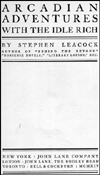

 |

Homepage |

Contents |
 |
The Structure of
Arcadian Adventures |
Below is a diagram illustrating the structure of Arcadian Adventures with the Idle Rich. By comparing the relatively simple narrative structures of both Sunshine Sketches and Arcadian Adventures, one notices that Leacock's vision of society is framed by the pragmatic realities of life: politics and economics. Set within this framework are the spiritual realities of life: love, family, social organization, and religion. It comes as no surprise that Leacock, as a professor of Political Economy, frames Arcadian Adventures and Sunshine Sketches by subjects (politics and economics) he considers most relevant to a complete conception of society.
This is what Robertson Davies means when he said that Leacock thought that "the advances of mankind were brought about by economic and political, rather than by spiritual" (Stephen Leacock. Canadian Writers no. 7. Toronto: McClelland and Stewart, 1970. p. 26).
In Arcadian Adventures we witness in the first two chapters a successful business man and a unsuccessful business man. Chapter 1 depicts a successful business maneuver when Fyshe releases the poor Duke onto his nemesis Boulder. Set up against chapter 1 is chapter 2, where an unsuccessful business man is found in Tomlinson. In chapter 4, Leacock exposes the follies of idleness in Mrs. Rasselyer-Brown, the quintessential Plutorian socialite. Chapter 5 is the mirror opposite of chapters 6 and 7. In chapter 5, Peter Spillikins' short sightedness in his relationship with Nora is a failure. The merger of St. Asaph and St. Osoph in chapters 6 and 7, on the other hand, is a success. Arcadian Adventures short-story cycle is then concluded in chapter 8 with an exposé of Plutorian politics. For a more thorough examination of Arcadian Adventures' structure see Gerald Lynch's Stephen Leacock: Humour and Humanity (Kingston, Ont.: McGill-Queen's University Press, 1988. pp.123-126).
| Chapter 1 |
"A Little Dinner with Mr. Fyshe"
(*success)
|
Economic |
Pragmatic
Realities |
| Chapter 2 |
"The Wizard of Finance"
(*failure) |
| Chapter 3 |
"The Arrested Philanthropy of Mr. Tomlinson"
|
| Chapter 4 |
"The Yahi-Bahi Oriental Society of
Mrs. Rasselyer-Brown" |
Social |
Spiritual
Realities |
| Chapter 5 |
"The Love Story of Mr. Peter Spillikins" |
Love/Family (*failure) |
| Chapter 6 |
"The Rival Churches of St. Asaph and
St. Osoph" |
Religion (*success) |
| Chapter 7 |
"The Ministrations of the Rev.Uttermust
Dumfarthing"
|
| Chapter 8 |
"The Great Fight for Clean Government" |
Political |
Pragmatic
Realities
|
Note: the asterisk mark, "*", beside the words "success" and "failure" refers to the oscillating narrative movement. Success is a turn upwards in the plot whereas failure is a turn downwards in the plot. These turns in the plot are only figurative outlines. See the above introduction for further details.
For a comparison with the structure of Arcadian Adventure press here for the structure of Sunshine Sketches.

Top |
|